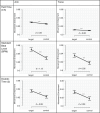Exploring movement entrainment in an ecologically valid concert setting
- PMID: 40877320
- PMCID: PMC12394413
- DOI: 10.1038/s41598-025-13376-7
Exploring movement entrainment in an ecologically valid concert setting
Abstract
Moving to the beat is one of the most natural human reactions while listening to music and can be defined as movement entrainment. Listeners' reactions to music have been discussed as the result of the music, the context, and the listener. However, as music is a social phenomenon typically performed in live settings, movement entrainment and its contributing factors have never been investigated in ecologically valid concerts. In a preliminary study (n = 42) during a rock/pop concert, we confirmed the validity of our method of measuring acceleration data of the audience with portable devices on the arm and torso. In our main study (n = 69), we measured audience data at two big band concerts with different conditions: One was seated, the other unseated. With several consecutive Hierarchical Linear Models, we identified factors predicting movement entrainment: location of measurement (arm vs. torso), metrical level (BPM vs. half- and double-time level), musical factors (the different pieces), concert condition (seated vs. unseated), and the personal characteristic of urge to dance. Our study shows that there are multiple factors contributing to movement entrainment and can be seen as a first step towards studying this phenomenon in ecologically valid concert settings.
Keywords: Dance; Live concert; Movement entrainment; Popular music.
© 2025. The Author(s).
Conflict of interest statement
Declarations. Competing interests: The authors declare no competing interests.
Figures



Similar articles
-
Prescription of Controlled Substances: Benefits and Risks.2025 Jul 6. In: StatPearls [Internet]. Treasure Island (FL): StatPearls Publishing; 2025 Jan–. 2025 Jul 6. In: StatPearls [Internet]. Treasure Island (FL): StatPearls Publishing; 2025 Jan–. PMID: 30726003 Free Books & Documents.
-
The Black Book of Psychotropic Dosing and Monitoring.Psychopharmacol Bull. 2024 Jul 8;54(3):8-59. Psychopharmacol Bull. 2024. PMID: 38993656 Free PMC article. Review.
-
Sexual Harassment and Prevention Training.2024 Mar 29. In: StatPearls [Internet]. Treasure Island (FL): StatPearls Publishing; 2025 Jan–. 2024 Mar 29. In: StatPearls [Internet]. Treasure Island (FL): StatPearls Publishing; 2025 Jan–. PMID: 36508513 Free Books & Documents.
-
Music-based therapeutic interventions for people with dementia.Cochrane Database Syst Rev. 2025 Mar 7;3(3):CD003477. doi: 10.1002/14651858.CD003477.pub5. Cochrane Database Syst Rev. 2025. PMID: 40049590
-
Music interventions for acquired brain injury.Cochrane Database Syst Rev. 2017 Jan 20;1(1):CD006787. doi: 10.1002/14651858.CD006787.pub3. Cochrane Database Syst Rev. 2017. PMID: 28103638 Free PMC article.
References
-
- Godøy, R. I. & Leman, M. Musical Gestures. Sound, Movement, and Meaning (Routledge, 2010).
-
- Lesaffre, M. et al. How potential users of music search and retrieval systems describe the semantic quality of music. J. Am. Soc. Inform. Sci. Technol.59, 695–707. 10.1002/asi.20731 (2008).
-
- Anonymous. Earth, Wind & Fire (ARC/Columbia 1-11093) In The Stone (3:32). Cash BoxXLI, 18 (1979).
-
- Merriam, A. P. The Anthropology of Music (Northwestern University Press, 1964).
MeSH terms
LinkOut - more resources
Full Text Sources
Miscellaneous

